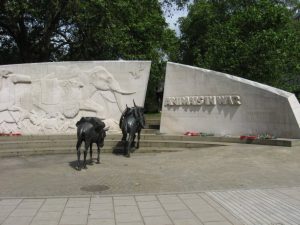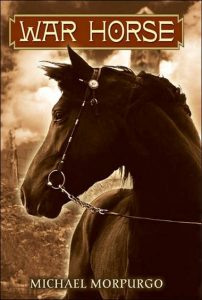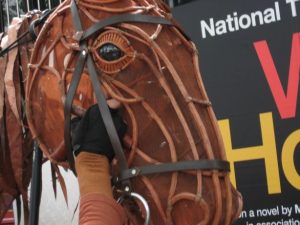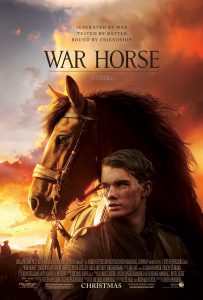This is the time of year when we look back at The Great War, which began on the 28th of July in 1914. The War to End all Wars was one of the largest wars in history, and it brings sharp images to mind about soldiers fighting in trenches, loss of life, and suffering. Most of these stories are about men being sent off into battle for their countries, but one of the more popular tales shifts away from that traditional format and instead shows us the War through the eyes of a fictional horse named Joey. There are three versions of this story: a book, a play, and a movie, and since all three are adored by their fans, I thought that, for this anniversary, I would give a little history on how Joey, Topthorn, and all of the characters became as much a part of our lives as so many other famous tellings of this moment in history.
The Book
The first incarnation of War Horse came about through a number of routes. Author Michael Morpurgo met three veterans of the Great War who had told him their stories. Wilfred Ellis of the Devon Yeomanry, Captain Budgett of the cavalry, and a villager named Albert Weeks all told of their interactions with horses in one form or another, either because they had served with them, or because they could remember when the army would enter local areas to purchase any horses they could find. Hearing these stories made Morburgo think seriously about showing the Great War through the eyes of a new character, a horse.
In an interview on BBC Radio 4, Morburgo explained his second motivation for writing the book came from a child who refused to speak because of a stammer. The boy was at a farm as a part of the Farms for City Children program, which Morpurgo and his wife had founded, and he was lost in conversation with a mare. The mare was intently listening to every word, and the two seemed to have bonded in this moment. The boy had found bravery, and the mare had found a purpose in being there for the boy in his moment of need.
The final inspiration for War Horse was an actual painting by F. W. Reed of horses trapped in barbed wire as they charged into battle. The painting was fictionalized for the book as a picture of Joey “Painted by Captain James Nicholls, autumn, 1914.”
I have to say that my own personal experience with reading War Horse has revealed all of these inspirational moments in the author’s life. Each of these examples is so perfectly included in Joey’s story that simply writing them down here brings to mind specific parts of the horse’s fictional life or the troubles and emotions of his owner, Albert. When it comes to other versions of War Horse, some are even more clear than others, such as the painting coming to life in the play as Joey struggles against barbed wire in his attempts to escape an oncoming tank.
The Play
Opening in London in 2007, the play was instantly recognizable by the use of life-sized puppets made by the Handspring Puppet Company. Controlled by three puppeteers, Joey and Topthorn steal the show for so many who attend. Videos of Joey interacting with real horses can be found all over the internet and his live appearances outside of the theater still draw over-sized crowds.
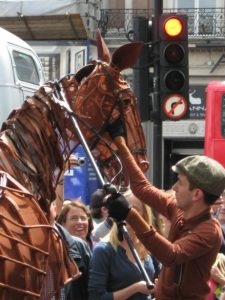
Joey reacting to the sound of emergency vehicles while performing at West End Live in London. The crowd was awed by the puppeteers’ ability to recreate a natural reaction.
Saying that the puppeteering is amazing is only expressing my opinion, of course. I have seen the play live several times, as well as been to the National Theatre live filmed version which plays in movie theaters on occasion. I am constantly amazed at how quickly I accept Joey and Topthorn as real horses, even with the puppeteers clearly visible. The play has a slightly darker feel, both visually and emotionally, than the book or the movie, perhaps because you are watching history come to life in front of you, or because of the staging. Whatever the reason, I am always left with the thought that we have experienced the play more through the horses’ eyes, even more-so than how we read it in the book or watch it in the movie.
The Movie
Fans of War Horse were given a holiday gift in 2011, when the movie adaptation was released in December of that year. This version has always felt more balanced when it comes to light and dark content, and it contains elements from the play (like the goose) that will have theater goers looking back at their memories of the live experience with great fondness.
There is more of an equilibrium between human and animal perspective as well, making the movie more of a story told by everyone, rather than something seen only through the eyes of a horse. Occasionally, a scene will push more toward what you would expect from Joey after having read the book, but most are just horse and human interaction, bringing to mind the story of the boy and the mare from the farm. The horses in this film are as much actors as the humans are, and the cinematography is simply stunning.
Why We All Need Joey
I have to say that of all of the stories that have been translated from book to play to movie, War Horse has always felt the most consistent throughout all of its incarnations, and it is a story that I have never grown tired of. Though my heart is really for Topthorn, I still feel a swell of amazement and love for Joey whenever I see his interactions on the streets. No matter how fresh some scenes are in my mind, it always touches my heart to see or read them again. War Horse is something that reminds us that hope can always be found in hard times and that humans weren’t the only ones who suffered in the War. So for this upcoming anniversary, seek out your favorite version of War Horse and remind yourself that not all soldiers from the Great War walked on two legs.
Mirrani Houpe, our Small Animal Editor, has had rats since she took home her first little boy once they both completed the second grade. Since that time she has owned, rescued and bred many kinds of rats, from many backgrounds. She may not be a vet, psychology major, or scientist, but her babies have her very well trained when it comes to how to care for them. She is constantly working with her family’s veterinarian to come up with new and innovative ways to love and care for the most often misunderstood rodent in the pet world. You can e-mail her at mirrani@yourpetspace.info

